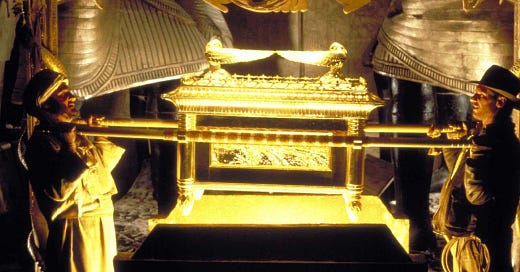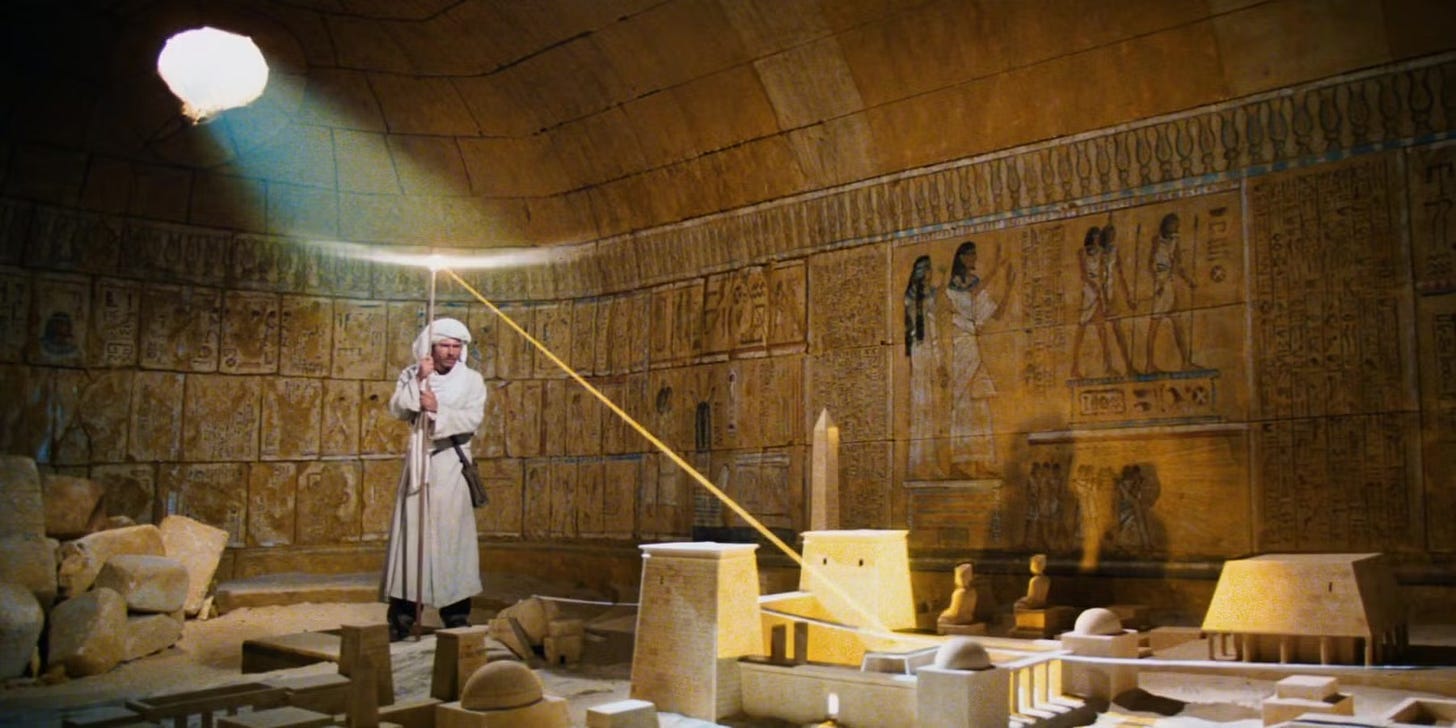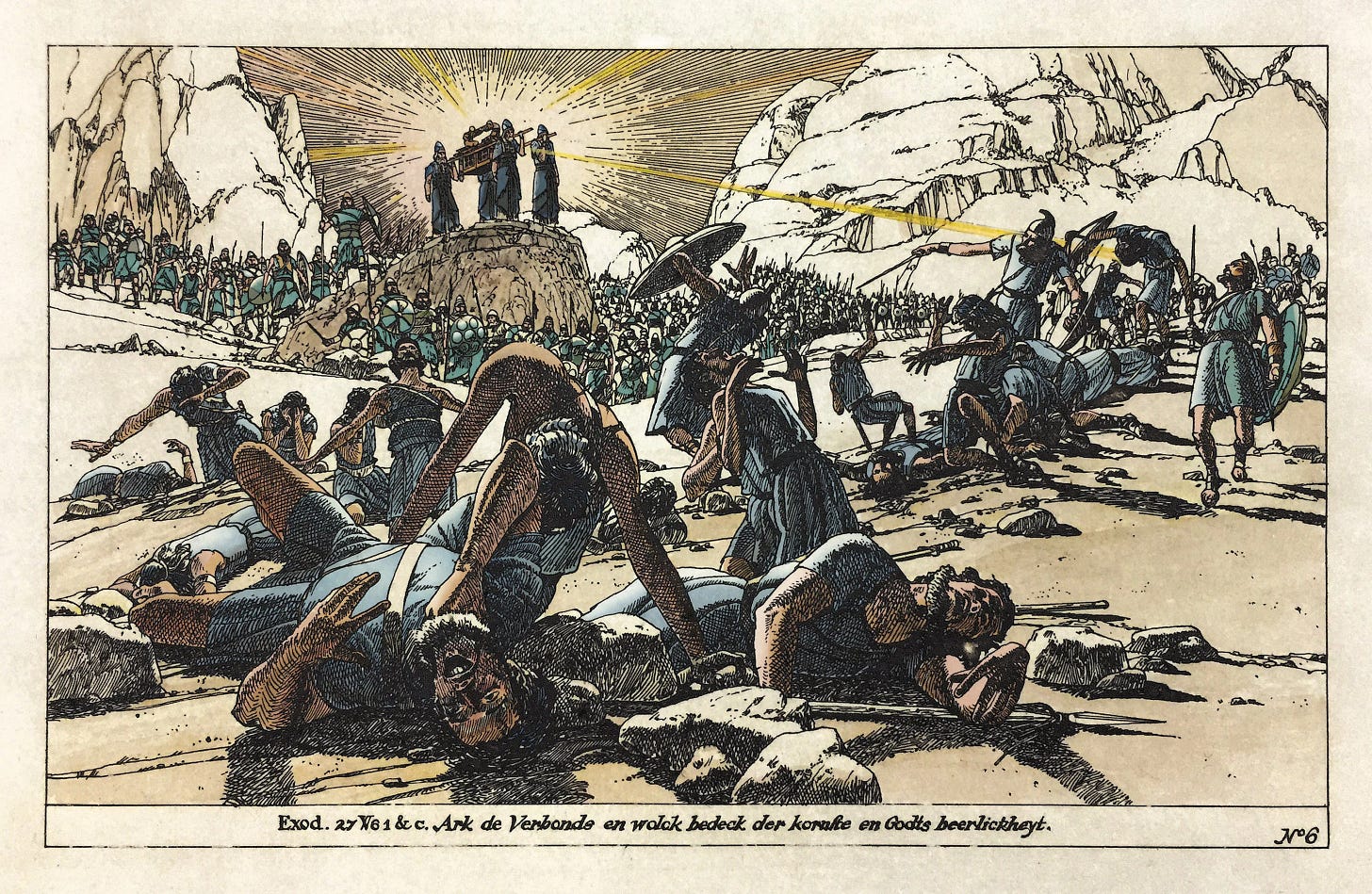There is likely nothing more iconic to the Indiana Jones franchise than the macguffin. Originally coined by Angus MacPhail and Alfred Hitchcock, a macguffin is an object that only exists to motivate the characters to get on their journey. Hitchcock felt it was inconsequential to the story he was telling, but for Indiana Jones, both George Lucas and Steven Spielberg felt differently. The Indiana Jones macguffins are important artifacts that have since taken on a life of their own. To celebrate the release of Indiana Jones and the Great Circle, it’s time to dive into the real life stories behind some of the most famous iconography in all of cinema history.
Indiana Jones and the Raiders of the Lost Ark sent the titular archeologist after one of the most important religious artifacts in all theaology: the Ark of the Covenant. According to George Lucas, Philip Kaufman, the writer of films like Rising Sun and The Outlaw Josey Wales, came up with the idea to use the Ark of the Covenant because his dentist was obsessed with the artifact. Kaufman helped George Lucas develop the story before Lawrence Kasden was brought on to write the script. The story of Raiders of the Lost Ark sees Indiana Jones get tasked by the government to retrieve the Ark before the Nazi’s do. Through the journey he reconnects with his lost love Marian, and the two travel to Egypt to find where the Ark was buried. The Nazi’s take controle of the Ark and when they open it, it kills everyone except for Indiana and Marion. The Ark gets placed in Area 51 by “top men” and is never seen again. You’ve seen the movie right?
Much of what is detailed about the Ark is written in the Book of Exodus. The second book of the Bible that details the Israelites leaving Egypt after God chose them as his people. Basically the plot of The Prince of Egypt. With less singing. Probably. Also known as the Ark of Testimony or the Ark of God, the Ark of the Covenant is considered to be one of, if not, the most sacred relic of the Israelites. The aforementioned Book of Exodus describes the ark as “a wooden chest, made of acacia wood (which is a type of tree in Africa), covered in pure gold, with an elaborately designed lid called the kappōret, or ‘Mercy seat.’” This is the part of the Ark that has the two cherubs and was apparently a seat for God. Most importantly, the ark contained the two stone tablets of the Ten Commandments, which had turned to sand by the time the Nazi’s got it in the movie. This was the Arks primary function, to hold the fabled Ten Commandments, but it was also meant to allow God to communicate with the Israelites directly.
The New Testament adds to the story by saying that a pot of manna and Aaron’s rod were also housed within the Ark. Aaron’s rod, for those who may not know, refers to any walking stick used by Aaron, the brother of Moses. The rod also had magical abilities during the plagues of Egypt, but its exact powers are left vague. Truthfully this seems like a “retcon” to the Book of Exodus since it is not mentioned in many texts. However, there is no reference in the bible or any other text referring to the Ark of a “Staff of Ra,” which was used by Indy to find the Well of Souls. So it’s possible that Lucas and co used Aaron’s rod as the inspiration for that particular artifact. Though that’s purely speculation.
The phrase "Ark of the Covenant" is a roundabout translation of the Hebrew term “aron habbrit”. Literally translated, that means “chest of the covenant.” In the Hebrew Bible, covenants represent contracts and promises between God and the Israelites. So the ten commandments were a covenant between them and represent the spiritual protection of God in exchange for them keeping the commandments. Somewhere along the way the term Ark was applied to the artifact. Ark comes from the Latin “arca” which means chest or box. So “Chest of the Covenant” became “Ark of the Covenant.” A box that literally held the contract the Israelites made with God. Apparently, also a seat for him.
The Ark appears in eight books in the Hebrew Bible, two books in the Christian New Testament, and various poetry and prophetic texts. According to the Book of Exodus, the pattern of the Ark was given to Moses by God when the Israelites were based at the foot of Mount Sinai, with its exact measurements as 4ft x 2ft by 2,5ft. It was created about a year after the exodus from Egypt (The Prince of Egypt). According to scripture, it is too holy to be put on the ground, or touched by anyone but “the chosen.” Might have meant “chosen people” or just Moses, but once again, the details are a little vague there. Because it couldn’t be touched, it had to be carried on poles inserted into the golden rings at all times. Some sources say that people weren’t even allowed to look at it so some depictions have something draped over the Ark. In Indiana Jones and the Raiders of the Lost Ark, the Ark is placed on the ground many times, which, as mentioned above, is blasphemous.
Because of its holiness, no one was supposed to directly touch the Ark, and it even killed one man who touched it. So this begs the question. Does the Ark have power as seen in the movie? The answer to this seems to be yes. When a man touched it in the Book of Kings to keep it steady as they cross uneven surfaces, he was instantly killed. When the Ark was stolen by the Philistine army in the Book of Samuel, the Philistines repeatedly had health issues and misfortunes, so they returned the Ark to the Israelites to prevent further misfortunes. A group of 70 people from Beth-shemesh who decided to look into the Ark were instantly killed for doing so. During the siege of Jericho, the Ark was toted around the city walls in a seven-day procession accompanied by seven priests sounding seven trumpets which made the city walls come tumbling down. The Hebrew Bible isn’t clear if it has power or if it acts as a conduit for God's power. Regardless, the ark is responsible for things like death, diseases, and just general misfortunes. However, It appears that the ghosts and melting faces are all made up for the movie. Even the image that Indiana shows the government agents is not a real bible image, but one created by Ralph McQuarrie. So there was a lot of creative liberty with the film.
One of the things that has plagued people for hundreds of years is whether or not the Ark of the Covenant is, or was, real. "Different people will give you different answers to that question," says Baruch Halpern, Penn State Professor of Ancient History, Classics and Ancient Mediterranean Studies, and Religious Studies. He continues "The Ark is a regular feature in the Old Testament, making several appearances in the first five books of the Bible. The various references to the Ark are pretty consistent and when you add it all up, it seems like the Ark was a real article." He’s basically saying the same thing that people say about dragons. With so many accounts, and all of them pretty consistent, how could it not be real?
So, if it’s real, where could it be? After the Jerusalem Temple was destroyed in 586 BCE, the Ark disappeared from history. Some claim that it was stolen while others claim it is on Mount Nebo, which is where Moses saw the Promised Land. A couple of places have claimed to have it but most popularly, the Ethiopian Orthodox Church claims that they’ve had it for centuries. According to church leaders, the Ark of the Covenant has been closely guarded in Aksum, Ethiopia, at the Church of St. Mary of Zion. Church authorities, however, won't let anyone see it because only one man, the “Guardian of the Ark” is allowed to see it. So no one can see if their claim is authentic. It’s a convenient cover story and unlikely to be true.
Another claim is that the Ark was hidden in a warren of passages beneath the First Temple in Jerusalem before the Babylonians destroyed it in 586 BCE. But that theory can't be tested either, because the site is home to the Dome of the Rock shrine, sacred in Islam. Digging beneath it simply isn't an option. Fun movie fact: This is the real life location of the Well of Souls. In the movie, it’s a temple filled with snakes and buried under the sand dunes, but it’s actually the name of a natural cave beneath the Dome Of The Rock. A couple of other possibilities for where the Ark could be currently are that it was hidden by priests under the Temple Mount for safekeeping, spirited away to an unknown site before the Babylonians even arrived in Jerusalem, removed by divine intervention, taken by an Ethiopian prince, or just destroyed in battle at some point in history, likely when the Babylonians destroyed the Jerusalem Temple.
In Indiana Jone and the Raiders of the Lost Ark the Ark was taken to the Egyptian city of Tanis by a Pharaoh. Because of that, the city suffered major sandstorms that wiped it from the Earth. This is actually one of the theories for where the Ark was taken after Juruselum. Shishak, the Pharaoh that attacked Jerusalem, stole many treasures, one of them is thought to be the Ark, and in the movie, that is the case. However the Ark ending up in Tanis is a guess from the film's writers since no text referencing this theory has ever named the location of where Pharaoh Shishak took the Ark. Tanis is a real place though. It was an abandoned Egyption city that was found by a man named Pierre Montet in 1939, rather than by Nazis in 1936. Many people today believe that Tanis has never been found, and Montet blamed World War II for his discovery not being talked about throughout his life.
That’s where the story of the Ark of the Covenant ends. It was a magical artifact that held the Ten Commandments, may or may not be real, and may or may not be in Egypt. Much of the story of the Ark that is in the film is close to the story of the “real” Ark, with only a few things reinterpreted or made up to add to the excitement of the story. The Ark set the trend for every macguffin coming with a price to pay for whoever uses it, and set a very high bar for the series. It’s one of, if not the most iconic film macguffin and was referenced in two future Indiana Jones movies as well as other adventure films.
Check out the episode we filmed of this report
Sources
Live Science - The Ark of the Covenant: https://www.livescience.com/64932-the-ark-of-the-covenant.html
National Geographic - The true story of the 'lost city' made famous by Indiana Jones: https://www.nationalgeographic.com/history/article/tanis-egypt?loggedin=true&rnd=1685765958137
Star Wars Explained - The REAL History of the Ark of the Covenant
Bible Study Tools - Ark of the Covenant - Bible Story: https://www.biblestudytools.com/bible-stories/ark-of-the-covenant.html
Britannica - Where Is the Ark of the Covenant?: https://www.britannica.com/story/where-is-the-ark-of-the-covenant








